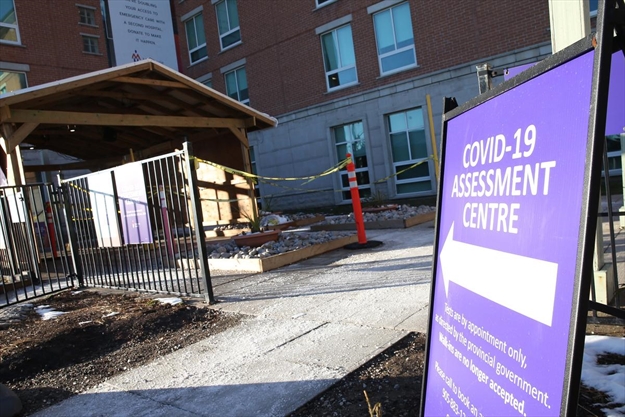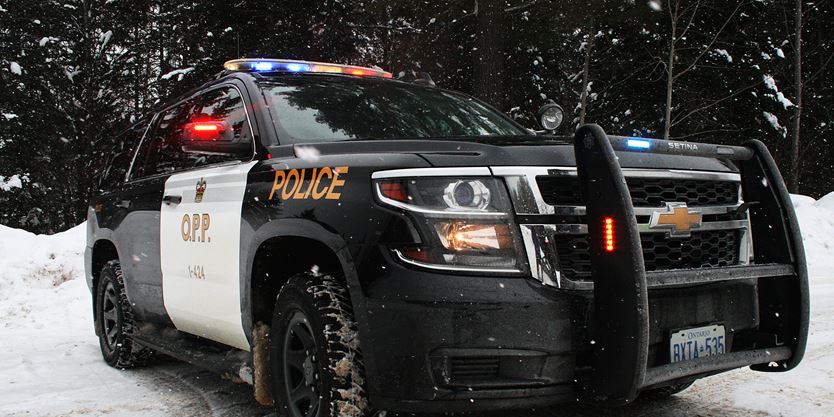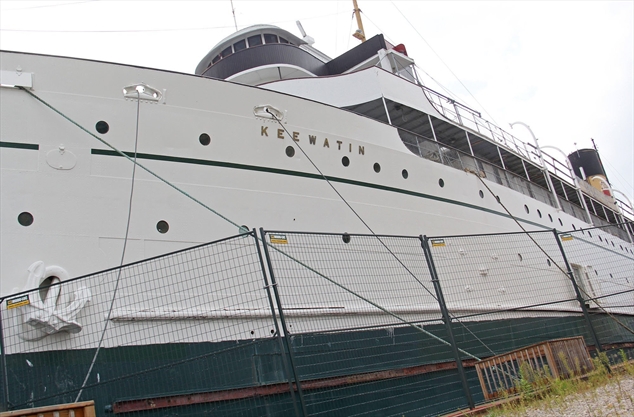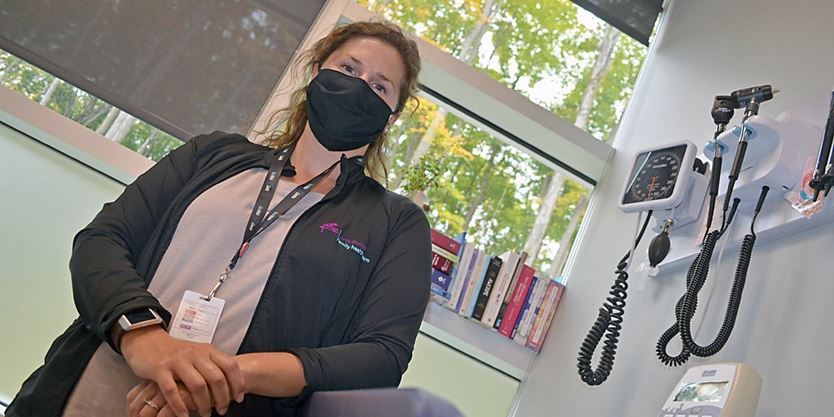KENORA, ONT.—Maryann Swain waves smoke from burning sage throughout the gym at the Gaagagekiizhik school, just as her grandmother taught her when they were being exposed to pathogens on their reserve. Today, in Ontario’s first Anishinaabe immersion school, the need to clear the room of negative energy is more urgent with the onset of .
“People are really scared here,” says Swain, an elder from Grassy Narrows First Nation. “Our people have seen plagues before.”
It’s a long-held tradition among the Ojibwe to disperse the negative energy before the annual fall feast, and at Gaagagekiizhik, where she teaches Indigenous youth about their culture they are reminded of a new challenge to ensuring the survival of their way of life.

COVID-19 is making every detail of school challenging at Gaagagekiizhik and Bimose Community High School, two schools housed in one building on Valley Drive.
It is the reason there are drums set out at this celebration, with drummers nowhere to be seen. Some will join via Zoom, but many don’t have an Internet connection. Still others are waiting for Chromebooks ordered in the summer.
It’s just the latest tradition affected by COVID-19, which is also playing havoc with the education system. And Gaagagekiizhik had to wait until late September to receive any extra funding during the crisis.
This came after administrators filed requests through Jordan’s Principle, a legal obligation that requires Indigenous Services Canada to fund and ensure Indigenous kids have access to the same services and support as other Canadians.
It’s been nearly three months since the federal government announced it would grant Ontario more than $300 million for getting kids back to school during the pandemic. That’s on top of the nearly $900 million the province distributed to school boards.
That announcement was in August but administrators say they still lack resources and are playing catch-up. COVID has left students who already face major challenges going to extremes for their schooling.
For instance, some students have to go to the McDonald’s or Tim Hortons parking lot for a Wi-Fi connection. The school is open, but half the students are learning online with unreliable Internet, or no Internet. When they can’t get online, they work from independent learning packages delivered by the bus driver and special education teachers.
Due to a handful of COVID-19 cases in October, three of which were found in local public schools, a sense of panic ensued at Gaagagekiizhik and almost half the students at the high school switched to online. The cases in Kenora schools were linked to travel from Manitoba, a 40-minute drive away. Manitoba has since posted record numbers of cases and deaths from the virus.
Since then, the Kenora region has seen an influx of new COVID-19 cases. The region had a 1.5 per cent positivity rate last week, its highest since the pandemic began.
In April, school boards across the province worked around the clock to ensure students had access to Internet, laptops, iPads and other technology. The problem at Gaagagekiizhik — which has 51 students in elementary, with 69 in the high school — is that it’s not part of a school board, nor is it on a reserve.
If it was in the board, it would have received some of the extra provincial funding announced in August. If it was on reserve it would have been targeted for some of the $112 million earmarked by Indigenous Services Canada for safe returns to school.
‘We honestly just gave up on it’
Swain, like many residential school survivors, doesn’t like to talk about the experience. She’s learned to overcome adversity. She says she was hopeful when she heard the Indigenous school called Gaagagekiizhik would open in the city, where children from the surrounding reserves could learn about their traditional language and culture.
Gaagagekiizhik opened in 2014, a year before the Truth and Reconciliation Commission of Canada released its Calls to Action. Two demands were to address the education gap and preserve languages.
The pandemic has shone a light on these gaps.
Administrators have noted the school reopening guidelines have been unclear, making daily operations difficult. It’s been harder at Gaagagekiizhik with no funding. School officials say they had to search for money for personal protective equipment and cleaning. Then they had to find a company accepting smaller orders.
Challenges like these delayed the opening until late September. Pre-pandemic, many public schools had libraries, librarians, computer labs, laptops and iPads. Gaagagekiizhik has none of these. The school principals say they rely on a shoestring budget.
“We honestly just gave up on it,” says Wendy McPherson, one of two principals at Gaagagekiizhik.
She says they couldn’t wait for governments, so she decided they would look after themselves.
Indigenous Services Canada said it provided $6,546 to the tribal council that runs the school on Sept. 21. This was for PPE and cleaning supplies, based on eligible students attending Gaagagekiizhik and Bimose Community High School.
Administrators at the school said this funding came through an approval process they had to file through Jordan’s Principle.
A lot of the school’s financing comes through the Principle, which has seen an influx of requests for education-related funding since COVID began, according to Indigenous Services Canada. Since March, Jordan’s Principle has approved $7.02 million worth of requests across the country related to COVID. These requests were for upwards of 9,000 kids.
At Gaagagekiizhik, when an administrator sees the need, they can apply to the fund to make sure the child is getting equal treatment. It means McPherson and other staff, on top of their daily work, are constantly applying for resources and then waiting up to six months for payment.
For instance, some students are returning to the school but others are choosing online learning at home. Administrators had to apply to Jordan’s Principle for money to buy Chromebooks.
They say without those funds there is no way they could purchase computers.
“Education is our buffalo,” says McPherson. “We would utilize every piece of that buffalo, and we will utilize every piece of that education. Education you can’t take away from people.”
The Chromebooks arrived at the end of October. The computers were finally deployed to students in mid-November, leaving the next challenge: teaching students to use them.
Although the challenges presented by COVID-19 and reopening sound daunting, school officials at Gaagagekiizhik are used to fighting for funding. Three years ago they had to get a Grand Council involved to demand funding for First Nations kids who live off reserve. Basically if an Anishnaabe child lived right down the street from the school, the Ontario government wouldn’t pay for that child to go to an Indigenous immersion school. The federal government was only obligated to pay for students living on reserves.
The discrepancy in education funding between students on reserve and off has been such a problem for that the Truth and Reconciliation Commission called in 2015 for it to end.
Several years later, the result at Gaagagekiizhik was access to provincial funds through reciprocal agreements with the school boards under Ontario’s education ministry. From now on, any Indigenous school started in an urban centre will not have to go through what Gaagagekiizhik did to fund all their students, and will enter the same kind of agreement with the province.
Gaagagekiizhik has still had to rely on Jordan’s Principle funds to hire teachers, purchase equipment and keep afloat in times of plague. But the short-term funding instalments and frequent delays make it impossible to plan.
Indigenous Services Canada says it provided $26,611 to First Nations communities on Sept. 21 to provide extra supports to students attending Gaagagekiizhik and Bimose school.
Immersion and emergency
When Darcy Wickham started teaching at the school in 2014, they didn’t even have a building. It was just him in a basement boardroom in downtown Kenora. He also had to travel to teach in Shoal Lake 40 and Grassy Narrows twice a week, 88 kilometres northeast to Grassy Narrows and 55 kilometres southwest to Shoal Lake 40.
This was before Shoal Lake 40 even had a road.
He took over as principal when Bimose Tribal Council purchased a building later that year. They still have a satellite school in Shoal Lake but shutdowns have forced remote teaching and online tutoring. Internet connectivity remains a hurdle.
“COVID’s messed things up in many ways,” says Wickham.
He says payments or reimbursement from governments come up to six months late. “We never had to worry about these things last year.”
Right now many of the students are working independently from home with booklets, a task he calls “monotonous,” adding that administrators designed the classes to be taught in person.
Additionally, Wickham says staffing has been a problem. As a federal school, Gaagagekiizhik does not have access to the public school board networks and infrastructure.
One of the biggest challenges is finding teachers fluent in Ojibwe language and culture. The school has been leaning on Maryann Swain more in recent weeks, along with her sister, Lillian. Ojibwe is one of several languages and cultures falling under the umbrella of the Anishinaabe.
Despite the challenges, they both prefer teaching at Gaagagekiizhik to the public schools.
“There were so many barriers for what I was trying to do,” says Lillian. “Anything to do with land-based learning, I couldn’t bring it into the classroom.”
The Swain sisters say COVID-19 has presented one opportunity. The ultimate goal of staff at Gaagagekiizhik is to adapt the Ontario curriculum and return to the language and culture as it was originally taught — in nature.
Land-based learning uses ancestral teachings embedded in activities such as fishing, hunting, harvesting medicines and food. This would mean subjects like math, science or social studies could be taught through the ancestral activities of harnessing the elements, creating a strong sense of identity.
Lillian Swain has now taken over for her sister teaching Ojibwe at Gaagagekiizhik, so Maryann can focus more as the school’s cultural resource. Lillian says the experience has opened her eyes: many parents don’t speak the language.
“It’s not just the teacher, teaching the language and culture,” says Swain. “They need to learn at home, too.”
That’s how Lillian and Maryann learned Ojibwe. When they came back from residential school, their grandmother and their mother taught them their language. Lillian says that ensured that she also passed it to her daughter.
But the Swains say other survivors of residential schools and the Sixties Scoop didn’t have anyone to teach them. That’s why they are passionate about teaching it, and making sure the Gaagagekiizhik students learn about their history.
The Swain sisters went to St. Mary’s Indian Residential School. It was on the Wauzhushk Onigum Nation reserve, also known as Rat Portage. Gaagagekiizhik is just a 10-minute drive from the old school site.
Maryann says the Anishinaabe way of life was interrupted and they need to bring back their language and culture. Ojibwe has many local dialects that fall under the umbrella of the Anishinaabemowin language.
For an endangered language like Anishinaabemowin, the time to teach it is now. In Treaty 3 territory alone, almost 60 elders have died in the last few months.
Four years ago, the tribal council that started Gaagagekiizhik made Oct. 3 Anishinaabemowin Day, declaring it to be under threat.
Between 1897 and 1972, generations of Indigenous children from surrounding communities were sent to St. Mary’s. Some of those kids are now grown-ups. Now they have set up their own school, and every year the population of Ontario’s first Anishnaabe immersion school grows.
St. Mary’s was just one of the residential schools. The curriculum at Gaagagekiizhik includes learning about the many others on Treaty 3 territory. This year students made their first walk to Cecilia Jeffrey Indian Residential School as part of Orange Shirt Day. Maryann offered a blessing for the children as they offered tobacco in memory.
“We try to teach our kids about residential school, and how they are lucky today that they get to go home,” says Swain. “Just to pick up the phone and talk to their mom and dad, those are the things we were never able to do.”
COVID-19, a global pandemic with no end in sight, has added a new layer of difficulty to teaching Indigenous language and culture.
Few options on reserves
When you meet some of the students from the reserves you understand clearly why the Swain sisters and tribal council fought so hard for an Anishinaabe immersion school in the city.
Lauren Mandamin is staying at her mother’s house with her five children. She was on her way back to their reserve in Northwest Angle 33, an isolated reserve on the edge of Ontario and at the edge of a lake, on the border between Manitoba and Minnesota.
But the lake has not frozen over, making it unsafe to travel. Their reserve is only accessible by boat and winter ice road.
Her children, Kayla, 11, and Tyler, 13, normally go to school in Dryden because there isn’t a school on their reserve. They have been attending online because of COVID.
“Sometimes it’s kinda hard,” says Kayla, who’s in Grade 6.
Zoom is hard for them in the city, let alone on reserve, where even the health clinic hasn’t had an Internet connection since last year. Both wish they were in a classroom — and wish they were learning about their heritage.
“It’s important to learn your past so you know more of your future,” says Kayla.
Kayla and Tyler were both students at Gaagagekiizhik when there was a satellite school on their reserve in Northwest Angle 33 First Nation.
Their mom, Lauren Mandamin, says her Angle Inlet reserve needs better infrastructure to support a real school. An old building was supposed to be a school, but it’s rotting in an area covered in swampland.
While students in the surrounding areas of Manitoba and Minnesota went back to school in September, children in this hidden corner of Ontario must hope for a stable Internet connection to join a class.
Grand Council Treaty 3 recently sent staff to 21 of the First Nations it represents, such as the Northwest Angle 33 reserves, to identify telecommunications gaps. In addition to applying for funding from the provincial government broadband fund, Grand Council Treaty 3 says it’s pressing Indigenous Services Canada Minister Marc Miller.
The council couldn’t visit all 28 First Nations it represents. Due to recent COVID spikes in Manitoba, Minnesota and Ontario, there are quarantines, lockdowns and limited access to reserves, requiring more online learning.
The future of Indigenous education
Kim Sandy-Kasprick grew up on the Angle Inlet reserve in Northwest Angle 33 First Nation, and says the school was once a community hub. She’s one among generations of parents who had to leave the reserve so their children could get an education.
Sandy-Kasprick says she worries about the kids still on the reserve trying to attend school online.
“Our students, our education system, our health system, child welfare system have all been underfunded and set up to fail,” says Sandy-Kasprick.
Northwest Angle 33 has not had a school since the early 1990s. The school was in such disrepair that the chief and council had to close it, sending the remaining students off reserve to study, says Sandy-Kasprick.
Like many band members, Sandy-Kasprick’s parents were residential school survivors. Her father became chief in the 1970s, and with other chiefs in the region, approached the federal government with proposals to educate children and adults on reserve, and teach land-based traditions.
In 1975, the Department of Indian Affairs promised an increase in education funding for children. Today, all that remains from the schools are monkey bars and swampland.
In 2013, on behalf of Northwest Angle and other First Nations, Grand Council Treaty 3 tried suing the government for breaching the “maintain schools” fiduciary duties to the beneficiaries of Treaty 3.
The Crown argued that the chiefs representing Treaty 3 were not authorized to bring the action for the rights holders, which the Crown asserted was 28 First Nations. The case was promptly dismissed.
Sandy-Kasprick was chief for Northwest Angle 33 at the time and says they wanted to fight the decision but didn’t have enough money.
It was around the same time that First Nations in the region were already trying to take matters into their own hands. The persistent lack of funding for their schools inspired six First Nations in Kenora to form the first Anishnaabe immersion school.
“In Canada, this is the first time a group of chiefs and communities have formed a school together,” according to the PhD dissertation by Bimose special education teacher Carly Christensen.
Christenson also wrote that the fact that the school is in Kenora, between the surrounding communities, means it is a reasonable commute for students.
In 2015, the Truth and Reconciliation Commission of Canada (TRC) released its findings detailing the impact of church- and government-run residential schools. There were 94 calls to action, including support for education, and a return of language and culture.
The government stated its commitment to meet these calls. However, in 2018 the Auditor General of Canada released a report stating Indigenous Services Canada’s main measure of socioeconomic well-being on reserves was inadequate, outdated and omitted a critical element of well-being — language and culture.
“In addition, the Department was still unable to report how federal funding for on-reserve education compared with the funding levels for other education systems across Canada,” the report reads.
Indigenous organizations have been tracking the completion of the TRC calls to action. While they await the implementation of Bill C-91: An Act respecting Indigenous languages, think tanks such as the Yellowhead Institute say it could take up to 40 years to see completion of the calls to action. COVID-19 means it could take even longer.
“Their response to the TRC has been haphazard and piecemeal,” says Brock Pitawanakwat, a fellow at The Yellowhead Institute and an associate professor at York University. He also spent three years as a senior researcher with the Truth and Reconciliation Commission.
Pitawanakwat says that in the early days of the pandemic people were trying to draw attention to the disparity in technology, and access to learning technology.
“It’s really followed socioeconomic lines,” he says. “And under these circumstances, this goes from kindergarten into post-secondary.”
Pitawanakwat says there has been noticeable improvement under the current government in terms of providing more funds for on-reserve education, but there is such a deficit that’s accumulated in terms of education infrastructure on reserves over the years.
“First Nations are still dealing with that infrastructure gap,” Pitawanakwat says. “Then the pandemic added on to that.”
Pitawanakwat says it’s important that education become part of First Nations self-government agreements, as seen in the development of Gaagagekiizhik. It’s a trend he says should continue at tribal council and national levels.
Another trend is the increased focus on land-based learning, the Anishinabe answer to the TRC’s call for culturally appropriate curricula, managed by Indigenous people.
This is how a strong sense of identity can be restored. It’s one reason why, in times of plague, the Swain sisters want to see more of a return to the land , and want the government to recognize their way of teaching.
After the fall feast at Gaagagekiizhik, and delivering gifts to the children in the classrooms, the Swain sisters took baskets of food to a nearby forest as part of an offering to the spirits, and some say, their ancestors.
“Our culture was interrupted,” says Maryann. “We forgot who we are. We have to live our culture and traditions”
Ryan Moore is a Master of Journalism graduate from Ryerson University School of Journalism. He’s worked on several collaborative investigations with the Toronto Star and other media outlets.





















